People
Collector Budi Tek on His ‘Mission Impossible’: To Give China Its First Public Contemporary Art Museum Before He Dies
The Indonesian-Chinese collector spoke to artnet News's Andrew Goldstein about his urgent quest to save his groundbreaking private museum.
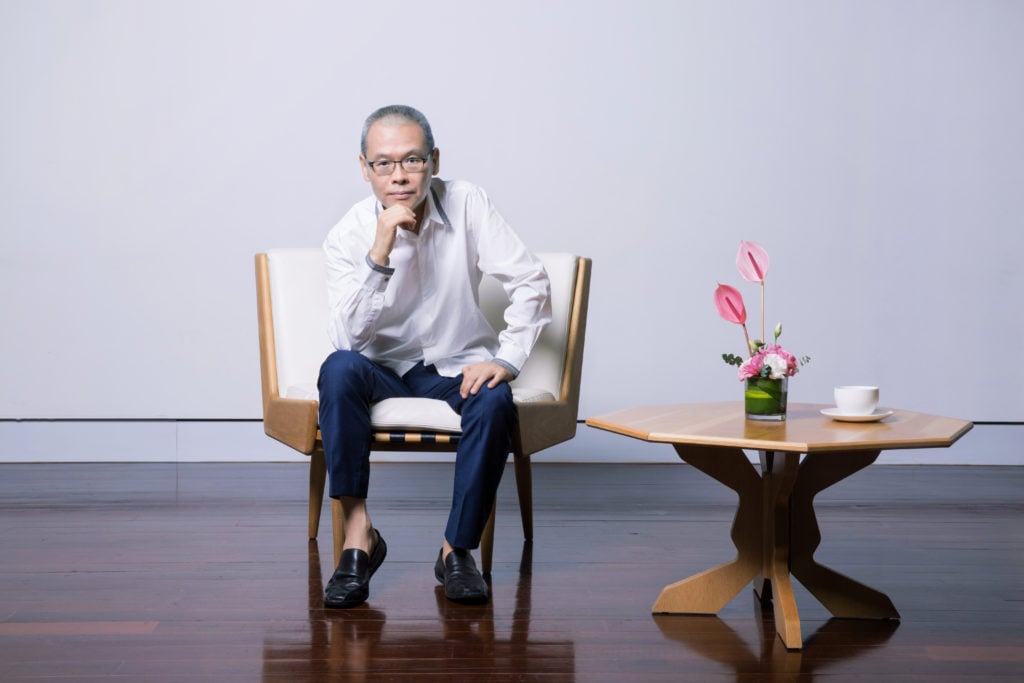
An outsize figure in the small but growing world of Chinese contemporary art, Budiardjo “Budi” Tek has always been a man in a hurry.
Born in Jakarta a little over 60 years ago, he made a fortune as the head of the vertically integrated poultry company PT Sierad Produce Tbk and began using his money to buy art in 2004. Things happened in quick succession after that: his collection grew to more than 1,500 pieces—with a focus on the Chinese contemporary art of the politically turbulent 1980s and ‘90s—and then he founded a museum for his collection in a 9,000-square-foot former aircraft hanger in Shanghai’s West Bund, naming it the Yuz Museum after the possessive of his Chinese name, Yu Deyao (so: Yu’s Museum).
Since then, he has produced dozens of shows, from spotlights on rising stars to landmark surveys of Giacometti and Warhol to blockbuster showcases of popular “mega-works”—to use Tek’s term—like Rain Room. His Yuz Foundation sponsored a Zeng Fanzhi show at the Musée d’Art Moderne de la Ville de Paris; and in 2017, he was awarded the French Legion of Honor.
One reason for Tek’s rapid pace is that his time has been cut precipitously short. Diagnosed with pancreatic cancer in 2015, he was initially given little hope of outlasting the year, but through a battery of treatments, combined with remarkable tenacity, he has managed to survive longer than the vast majority of people with the virulent illness.
On the phone, the collector betrays no trace of sluggishness—in fact, he is a wellspring of ebullience and sly humor, particularly when talking about his dream: to transform his private Yuz Museum into a public institution and thereby lay the groundwork for his adoptive country of China, which to date has no real museums of contemporary art, to more fully embrace the extraordinary cultural output of his time.
Last year, Budi, who had struggled to bring his vision to life on his own, stunned the world by announcing that his Yuz Foundation would be joining with the Los Angeles County Museum of Art in a historic partnership that would ensure his museum would outlast him.
Here, in part one of an interview with Tek—which has been edited and condensed for clarity—artnet News editor-in-chief Andrew Goldstein spoke to the collector about why he feels China needs his museum to last and the challenges he encountered finding a way forward. In the second half of the interview, Tek will address the LACMA deal and what it holds for the future.
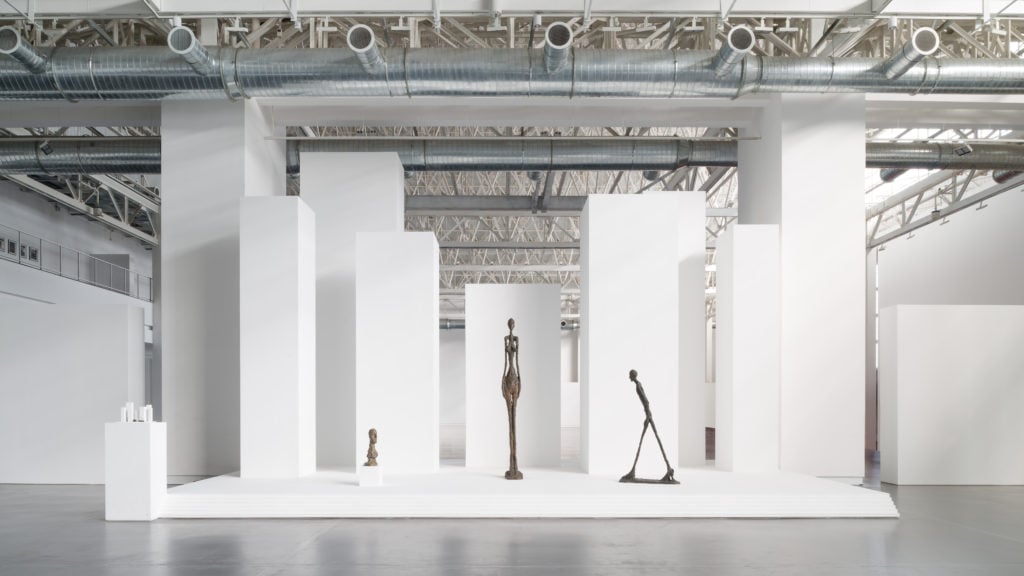
The Yuz Museum’s 2016 Giacometti retrospective, the first such show of the artist in China. Photo courtesy of the Yuz Museum.
You first began collecting art seriously 15 years ago. Now, you have a foundation and a massive museum in Shanghai. Most importantly, perhaps, you are revolutionizing the very idea of what an art museum can be in China, partly through your historic partnership with LACMA. That’s a lot to have accomplished in a relatively short amount of time. Most interestingly, it seems to be in the service of a larger idea. The Yuz Foundation lists that one of its core principles is to promote the “art museum movement.” What does that mean?
Years ago, when I made that statement, there weren’t any truly serious institutions in China with substantial collections in contemporary art. After my good friend Uli Sigg donated the bulk of his collection to M+ in Hong Kong [in 2012], we collectors discussed the fact that if you wanted to see Chinese contemporary art history [at that time], you had to travel from China to Hong Kong.
That worried everyone, including me. But I was optimistic. I said to my friends, “I think that China will soon have a museum movement,” and in three years, we saw many private museums established, including the Yuz Museum. The judgement about the art in the Yuz Museum should be made by objective individuals like yourself, but I can say that it was one of the first serious contemporary museums in China, especially in Shanghai.
I was very proud that Shanghai could become one of the pioneers of the museum movement. About a year after we established the museum, I was invited to London to talk with other private museum owners, and the last question they asked everyone was, “What do you want your museum to be 30 years from now?” Everyone said they wanted to be like MoMA, or Tate. I said that I didn’t know what would happen 30 years from now, but that if you look around New York, you have the Frick, the Whitney, the Guggenheim—all of these were once private museums. I wanted the Yuz Museum to also one day become a public institution.
There are several important state-run historical museums in China, and then there is a small but growing number of significant private museums in Shanghai, Beijing, and elsewhere in the mainland. But there aren’t any real state-run contemporary art museums in China. Why is that? It’s widely understood that an engagement with contemporary art creates a certain kind of soft power that, together with cultural and economic capital, could be useful for a country as ambitious as China.
The government people may see the contemporary art museum as a cultural phenomenon that isn’t comprehensible to non-art people. And you can’t blame them, because China has a 5,000-year history, and we have such rich historical art and culture. But I told my friends that when we glorify our ancestors, we need to also glorify ourselves; future generations will be proud of us because we did something to preserve this contemporary moment.
But then, at the same time, frankly speaking, the majority of so-called “artworks” in the world are actually crap. They are very commercial. When we look back 50 or 100 years from now, which ones will actually remain in the history of art? This is a very long process, and that’s why it’s fair enough to say that the private museum will be the pioneer to help establish the soft power of the future. I think the state contemporary art museum will one day harvest our hard work like a farmer, but you need to plant before you can harvest.
Because I got pancreatic cancer three years ago—and I’m still alive three years on, and I intend to survive long into the coming years—the urge in my heart is to do something before I’m gone. If I wasn’t sick, it might have taken me another five to 10 years to think of what I’m thinking today. But because of this sickness, this crisis, I had to speed everything up, and that’s what led me to the conclusion that I need to turn the Yuz Museum to a public institution.
Of course, it’s very difficult. I would need to donate the majority of my collection to a public foundation in order for the government to support us. But if I don’t do this, people would say, “You know, Budi, you’re not doing anything, you’re just talking.” So when I met Michael Govan from LACMA, I said, “Would you like to help push that transformation of a private museum into a public museum in a very short period of time?” When I talked to him, I didn’t know if I’d survive six months or a year. So the crisis has actually pushed me to “mission impossible” mode.
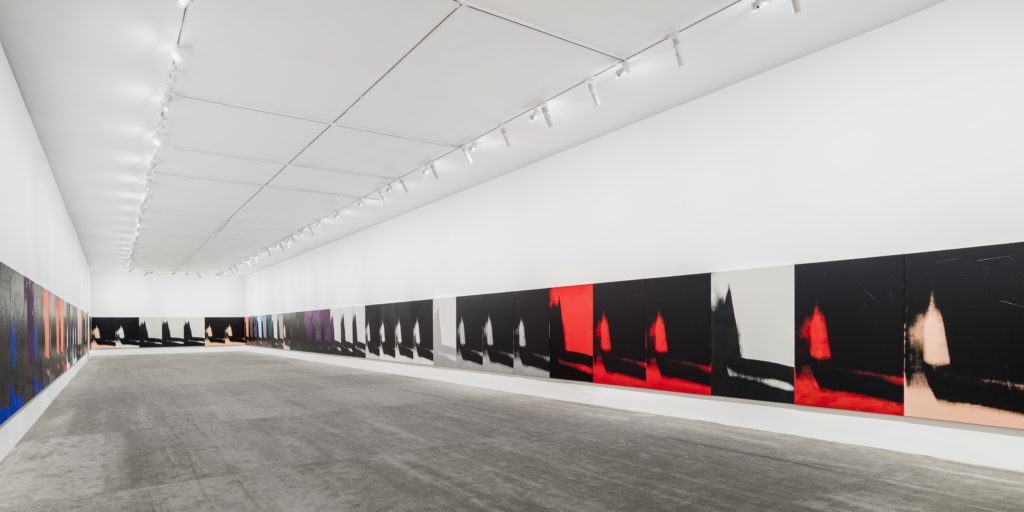
The Yuz Museum’s show of Andy Warhol’s “Shadow” series in 2016. Photo courtesy of the Yuz Musuem.
You’ve spoken often about your desire to share your art collection with the world, to make it public. Why is this important to you? Why does the world need your art? What use is it to the world?
I believe I’m the second person to assemble a rather rich, if not complete, collection of Chinese contemporary art from the 1980s to 1990s, a period that is very important to the history of art in China. I collected hundreds or even thousands of works of art—and here we are not talking about Budi, we are talking about the Yuz Foundation.
So, this is the kind of valuable collection—although I bought it about 15 years ago for relatively reasonable prices at the time—that some members of my family who love art will keep, but others who may not love art? If they see a good price, they will sell it! Both me and my wife Michelle, who is herself a very important figure in this field, think that it’s better if we keep the collection in one piece so we can leave a legacy, rather than to give away the art to family members.
We’ll be establishing the kind of legacy that can actually benefit every member of my family—because the name Yuz, the name Tek, would benefit them more in the future than an extra dollar would. This collection may not be important in the West in the history of art, but it is very important in China. And, again, then you won’t need to go to Hong Kong to see contemporary Chinese art history—you can go to Shanghai! Of course, if the collections in Shanghai and Hong Kong combined, it would be very complete.
I believe there are close to 1,500 private museums in China, but because the phenomenon of private museums is relatively young there, it doesn’t seem like there is an established mechanism for these museums to outlast their founders. Why is that?
The majority of the so-called “private museums” don’t have collections. This is actually the critical problem. Because the government would like culture to be a part of everyday life, they provide incentives for real estate developers to include a kind of cultural setup in their plans. I’m proud that we’re in a moment when the government is supporting the culture, but it also means that many of the so-called “private museums” are actually just exhibition halls. One day in the future—maybe another five, 10 years—they might start to realize that museums need to have collections, and then they’ll understand the necessity of having good artworks. But today, if you are talking about 1,500 museums, maybe only a few dozen have actual collections.
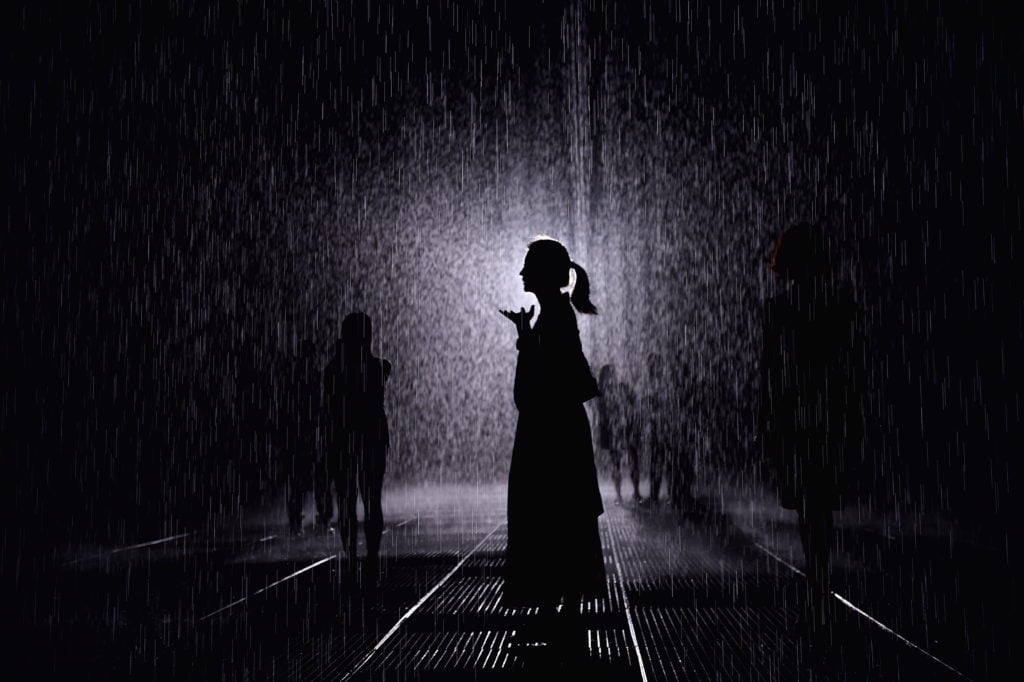
Random International’s “Rain Room” was displayed at the Yuz Museum in 2018. Photo courtesy of the Yuz Museum.
One might imagine that one reason it’s difficult to get government support for a public contemporary art museum is because so much of China’s contemporary art was made during a tumultuous chapter of the country’s history. What would you say to that?
In my understanding of contemporary art, the United States was actually very weak culturally compared to Europe, if I may say, before World War II. Since you don’t have a real history—or you only have 200-plus years of history—everything you learned was coming from Europe. But after the war, you created the Big Bang of recent cultural history. Afterward, postwar contemporary art was mostly driven by the United States.
Similarly, after Deng Xiaoping opened up the country 30 years ago, China started to be liberated economically, politically, and culturally, and you saw the contemporary art movement begin to blossom. That was a historical moment that was being recorded on canvas, in sculpture, installation, photography, video. People have started to realize that those moments are important, which is why the artworks from 1980s and ‘90s are now expensive.
But how about 50 years from now? Today’s works could be as important as those of the ‘80s and the ‘90s. My life is going to be ending—everybody’s life is ending—but the artworks will have a much longer lifespan than us, because they recorded history. It’s very special for me to be the keeper of this history.
In China, there is a “big me” and a “small me.” So, this is a “small me” speaking now; to become the “big me” you need to sacrifice yourself to contribute to the greater “me,” which is society—the world. I am also a Christian, so I believe in the Bible, and it says that giving is more blessed than receiving. Maybe because of that I experienced a miracle. All the doctors said, “You only have six months to a year,” and I’m getting better each day. So, if you were in my position, you would see why I have the urge to give. I don’t know how long I will live, but I intend to live longer.
After you were diagnosed with pancreatic cancer and you resolved to create a framework for your museum to outlive you, it seems one of the key challenges you faced was a very pragmatic one: who will pay to operate the museum once you’re gone? How willing has the government been to help fund your museum in the past?
The government never really funded my museum—their only help has been to sometimes give us very limited funds to support our cultural activities, but that is a very, very small part of our funding. Last year, we didn’t even get a cent. So the question I asked myself was, “Budi, if you are not around, who will be willing to open up their pockets to fund the museum?”
When you first founded your museum, did you realize it would be such an expensive project?
Nobody knows! After a year or two, I started to realize: wow. Yuz Museum shows are very high quality—we never compromise on the quality of the exhibitions. We’ve had many influential shows, like the Giacometti show, Warhol, KAWS recently, and even more recently, the Gucci-sponsored show curated by Maurizio Cattelan.
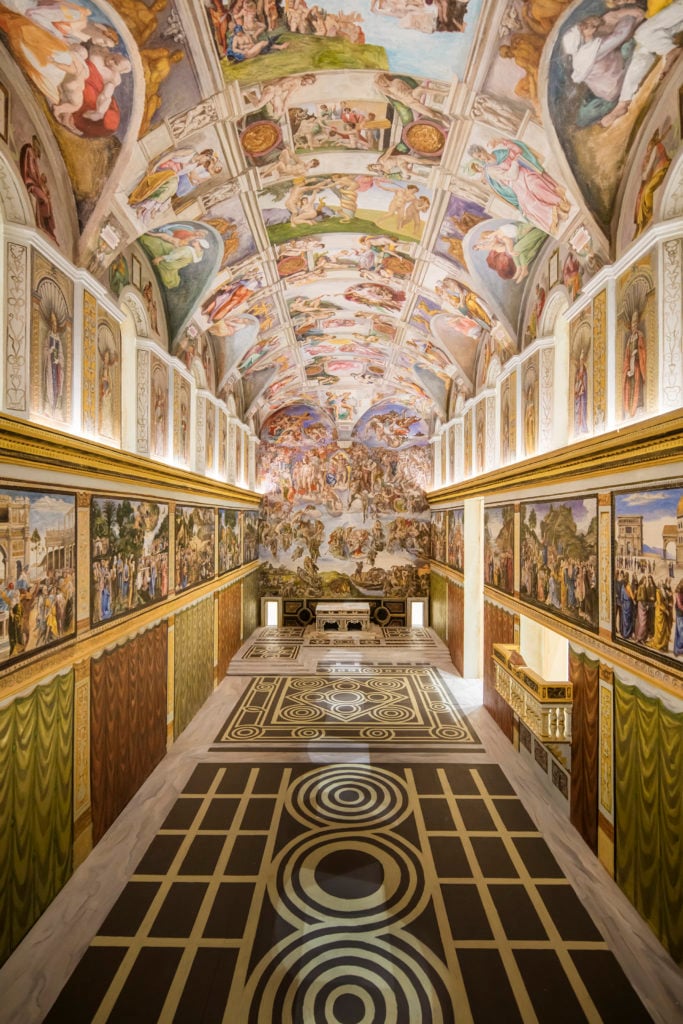
The Gucci-sponsored “The Artist Is Present” show in 2018, curated by Maurizio Cattelan. Photo courtesy of the Yuz Museum.
The Gucci show was fairly innovative, in that there are sensitivities for Western museums to do exhibitions with such clear brand sponsorship. Is there there less sensitivity around such partnerships in China?
When I deal with brands, I ask who the curator would be. If the curator is someone very commercial, I’d say no. But with Gucci, they invited Maurizio Cattelan, a great artist, to be the curator, and I collect his work and believe in him. I knew he would do a very objective and noncommercial show. It was like when “Rain Room” was sponsored in part by Volkswagen—they didn’t put any branding of their product in the museum, we just featured their name. That is our principle with sponsorship—you’ll have an established brand relationship, but you won’t see product in the show.
You were a successful businessman before you entered the museum world. What are some of the lessons from your business career that guide you as you chart the financial sustainability of your museum going forward?
Whether it’s business or not business, you need to follow your principles. I want the museum to be seen as academically sound—a respected, quality museum—rather than having people say, “Oh, this is a commercial museum.” For instance, someone might say, “I’d like to rent a space for a month to show my work”—it happens in China. But we never entertain those kind of shows, because they just want to say that they had a “show at the Yuz Museum.”
Such a show would help the artist, but it would damage your museum’s long-term credibility in exchange for a relatively ephemeral amount of money.
Yes. That is a principle we follow very closely. There was one mistake that happened when I was in the United States for my six-to-seven-month treatments, when one of my foundation’s directors let in the kind of show that put products in the museum. I let him go immediately. I said, “I’m sorry, you compromised our principle with those products.” But we’ve only had one single mistake in four years.
http://www.ftchinese.com/story/001074859?full=y
與FT共進下午茶:余德耀
薛莉:談興甚濃的余德耀在兩個半小時裡坦率談及所患的重病以及他目前的重中之重——余德耀美術館的傳承。
與余德耀先生的訪談約了很久,因他的健康原因,一推再推。終於,在他位於浦東黃浦江畔的宅邸,喝完了長達兩個半小時的“下午茶”。雖然重病在身,余先生精神很好,但面容消瘦,著T卹休閒褲。一樓客廳的牆上掛著藝術家周力的巨幅作品《戀》(200x300cm),前面擺著他女兒的電子樂器。他步速較慢,把我帶到2樓的小會客室,選了個舒服的沙發靠坐著。我們聊了兩個多小時,他幾乎沒怎麼換姿勢,也很少喝茶。
 余德耀(圖片為本人提供)
8月13日,上海徐匯西岸藝術區的余德耀美術館,印尼華人、收藏家余德耀先生接受了“法蘭西共和國榮譽軍團軍官勳章”的受勳儀式。法蘭西共和國榮譽軍團勳章是法國政府為表彰為法國做出貢獻並推動社會進步的傑出人士頒發的國家級最高榮譽。金庸、馬雲也曾獲得過這個榮譽的騎士勳章,余德耀此次獲頒的軍官勳章,比前者高一個級別,華人中僅有董建華、陳竺等少數幾人獲得過。
然而,除了余德耀美術館、刷爆微信朋友圈的藝術展覽《雨屋》之外,中國藝術圈外對“余德耀”所知甚少。
中國當代藝術大藏家
余德耀,本名Budi Tek,這是他的印尼名。他出生在印尼,父母是印尼華人。在那個時代,為了獲得印尼籍,他必須為自己取個印尼名字。但他一直認為自己是中國人,余德耀美術館的英文是“YUZ”,意為“余氏”。隨著印尼政策的改變,他給四個在印尼出生的孩子都起了中國名字。
生於家境殷實的華商之家,余德耀赴美留學後回印尼創業,所創立的農業集團一度發展成印尼業內翹楚,覆蓋飼養業、冷凍食品加工業、動物保健等領域。生意輝煌的時候,集團在全球有四百多家餐館。
2004年,余德耀買了第一件藝術品,中國當代藝術家郭晉創作的《騎單車的男孩》,把它掛在辦公桌後的牆上,尺寸剛好合適。這幅作品的尺寸為345cm*210cm,直到現在,他還經常買超大尺寸的藝術品包括藝術裝置,因而被稱為“Crazy Budi Tek”。最典型的莫過於收下藝術團體蘭登國際的作品《雨屋》。
余德耀(圖片為本人提供)
8月13日,上海徐匯西岸藝術區的余德耀美術館,印尼華人、收藏家余德耀先生接受了“法蘭西共和國榮譽軍團軍官勳章”的受勳儀式。法蘭西共和國榮譽軍團勳章是法國政府為表彰為法國做出貢獻並推動社會進步的傑出人士頒發的國家級最高榮譽。金庸、馬雲也曾獲得過這個榮譽的騎士勳章,余德耀此次獲頒的軍官勳章,比前者高一個級別,華人中僅有董建華、陳竺等少數幾人獲得過。
然而,除了余德耀美術館、刷爆微信朋友圈的藝術展覽《雨屋》之外,中國藝術圈外對“余德耀”所知甚少。
中國當代藝術大藏家
余德耀,本名Budi Tek,這是他的印尼名。他出生在印尼,父母是印尼華人。在那個時代,為了獲得印尼籍,他必須為自己取個印尼名字。但他一直認為自己是中國人,余德耀美術館的英文是“YUZ”,意為“余氏”。隨著印尼政策的改變,他給四個在印尼出生的孩子都起了中國名字。
生於家境殷實的華商之家,余德耀赴美留學後回印尼創業,所創立的農業集團一度發展成印尼業內翹楚,覆蓋飼養業、冷凍食品加工業、動物保健等領域。生意輝煌的時候,集團在全球有四百多家餐館。
2004年,余德耀買了第一件藝術品,中國當代藝術家郭晉創作的《騎單車的男孩》,把它掛在辦公桌後的牆上,尺寸剛好合適。這幅作品的尺寸為345cm*210cm,直到現在,他還經常買超大尺寸的藝術品包括藝術裝置,因而被稱為“Crazy Budi Tek”。最典型的莫過於收下藝術團體蘭登國際的作品《雨屋》。
 《雨屋》展覽海報
余德耀回憶道:“那時到紐約拜訪一個小畫廊,他們給我看了《雨屋》的VIDEO, 當時在MOMA展過,倫敦也展過,我覺得很有趣,但沒有太多的感觸。後來在倫敦,他們把我帶到藝術家工作室,然後我對這件裝置作品的印象立馬改變了,很快決定要買。”這件作品當時是一百平方米,余德耀覺得不夠大,他對藝術家提出“一百平方米太小,能不能做兩三百平方米?”講到這裡,余德耀回憶說:“藝術家也很興奮,覺得碰到了'土豪'。後來他說最大能做到150平方米。 ”就這麼成交了。150平米的最大《雨屋》成了2015年轟動中國的現象級展覽,也為余德耀美術館帶來瞭如願以償的知名度。
從余德耀的收藏中,很難讀出他的個人偏好。他的收藏中,70%是中國當代藝術,除此之外,也收了些亞洲藝術和國際藝術品。而在中國當代藝術品,從張曉剛到周春芽,從大型裝置到影像藝術,幾乎無所不包。
對自己收藏的定位,余德耀表示想“收藏中國當代藝術史”。他說:“我是根據藝術品在藝術史上的重要性來收藏的。”中國當代藝術品的瑞士大藏家烏利希克也表示自己建立的是一套“文獻”收藏體系。2012年,烏利希克將1463件中國當代藝術品捐贈給香港M+視覺藝術博物館,M+另外向希克購入47件藏品。余德耀說:“現在中國內地沒有一個美術館能讓中國學藝術的學生觀摩中國當代藝術史的,這很可悲。以後如果你要看中國當代藝術史,可能你要去香港。”余德耀的很多藏品是在二級市場購得的。因此他說:“我的藏品沒有希克的那麼多,但我們的藏品比較精,重要的藝術家,我都有經典的幾件。”
展覽要做全球最牛的
雖然《雨屋》展覽為余德耀美術館帶來很高的大眾知名度,但更讓它獲得藝術界內業認可的則是《賈科梅蒂回顧展》。
《雨屋》展覽海報
余德耀回憶道:“那時到紐約拜訪一個小畫廊,他們給我看了《雨屋》的VIDEO, 當時在MOMA展過,倫敦也展過,我覺得很有趣,但沒有太多的感觸。後來在倫敦,他們把我帶到藝術家工作室,然後我對這件裝置作品的印象立馬改變了,很快決定要買。”這件作品當時是一百平方米,余德耀覺得不夠大,他對藝術家提出“一百平方米太小,能不能做兩三百平方米?”講到這裡,余德耀回憶說:“藝術家也很興奮,覺得碰到了'土豪'。後來他說最大能做到150平方米。 ”就這麼成交了。150平米的最大《雨屋》成了2015年轟動中國的現象級展覽,也為余德耀美術館帶來瞭如願以償的知名度。
從余德耀的收藏中,很難讀出他的個人偏好。他的收藏中,70%是中國當代藝術,除此之外,也收了些亞洲藝術和國際藝術品。而在中國當代藝術品,從張曉剛到周春芽,從大型裝置到影像藝術,幾乎無所不包。
對自己收藏的定位,余德耀表示想“收藏中國當代藝術史”。他說:“我是根據藝術品在藝術史上的重要性來收藏的。”中國當代藝術品的瑞士大藏家烏利希克也表示自己建立的是一套“文獻”收藏體系。2012年,烏利希克將1463件中國當代藝術品捐贈給香港M+視覺藝術博物館,M+另外向希克購入47件藏品。余德耀說:“現在中國內地沒有一個美術館能讓中國學藝術的學生觀摩中國當代藝術史的,這很可悲。以後如果你要看中國當代藝術史,可能你要去香港。”余德耀的很多藏品是在二級市場購得的。因此他說:“我的藏品沒有希克的那麼多,但我們的藏品比較精,重要的藝術家,我都有經典的幾件。”
展覽要做全球最牛的
雖然《雨屋》展覽為余德耀美術館帶來很高的大眾知名度,但更讓它獲得藝術界內業認可的則是《賈科梅蒂回顧展》。
 《賈科梅蒂回顧展》
本來,余德耀與賈科梅蒂基金會總監、策展人凱瑟琳•格雷妮爾商量做一個小型賈科梅蒂展,只用二樓的一個展廳做。余德耀回憶說:“15年,法國駐中國大使館文化參贊希望把這個展推薦給中國政府,做成國與國之間的高級別文化交流活動。”但余德耀需要向中國政府承諾,使用自有資金辦展。他主動對凱瑟琳提議:“既然是已經高級別了,我們是不是把展覽內容提升一下,變成全球最牛的展覽?”他說:“畢竟是中國,什麼都要最大、最牛!”在採訪中,他屢次這麼說。
余德耀沒有透露辦這個展究竟花費了多少,但這個展覽展出了賈科梅蒂從早年到1960年代不同時期的作品,包括石膏、青銅雕塑,以及主要的繪畫、手稿、攝影和檔案資料,總數達250件。余德耀說:“我們把賈科梅蒂的Studio也搬過來了,給大家看他是在這麼小的工作室裡,做出了這麼多偉大的作品。把他的咖啡廳也搬過來了,可以看到他的小資生活。”
提起這個展,余德耀至今仍然興奮。他回憶說:“當時泰特美術館也要辦一個賈科梅蒂展,他們的館長對我說:'我們辦不到這個樣子。'”
在余德耀看來,美術館是思想、藝術的殿堂,是一個城市的重要地標。高標準布展,既是對藝術家和藏品的尊重,也是對藝術行業本身的尊重。為此,他直言不諱地批評過蓬皮杜藝術中心。2016年,商業展覽公司上海天協文化曾在上海展覽中心主辦了“蓬皮杜現代藝術大師展”,從蓬皮杜藝術中心精選了70多件藝術精品,包括畢加索、馬蒂斯、夏加爾、勞倫斯、康定斯基等藝術大師的作品,一度在上海掀起一陣“蓬皮杜”熱。但余德耀認為,蓬皮杜藝術中心這麼重要的藏品,應該在更適合的藝術空間展出,而不應該在商業空間裡展出。他說:“上海展覽中心的場地條件非常差,層高,柱子都是不對的。蓬皮杜不尊重自己的藏品。”
未竟的使命
近兩年前,余德耀被查出患有胰腺癌。之後手術、化療,反反复復進出醫院,最近的檢查顯示,癌細胞已轉移了。
仰靠在沙發靠背上,余德耀冷靜地,語速均勻地對我說:“我這個癌是'萬癌之王'。我的身體已經沒有辦法接受第二次化療。從科學的角度推斷,我這種病情也就是這一年的事了。既然上天要叫我回去,我也沒有辦法。但我很期望能夠撐下去。雖然我已經接納了這個事實,但是我要FIGHT ,超過一年,就是我的BONUS,或者能不能超過兩三年?我會得寸進尺。”
余德耀堅持散步,每次走30分種,每天兩三次,也用中醫食補,除此之外,他說:“我還要管理家人的傷感,安撫我的老婆、我的母親。”堅強如他,偶爾也會傷感,“我偶爾也會覺得,這麼好的一個家,我不在了,怎麼辦呢?”有時也會心生異想:“本來我就是有拋棄心的人,死對我來說,也是很奇妙的事,也許是跑到另一個空間去了,這會讓人覺得有點興奮。我並不怕死。但這並不是說我不留戀這個世界。”
然而,對余德耀來說,比處理重疾更急迫的是處理藝術藏品。現在徐彙的西岸館空間有限,根本放不下他的藏品,更何況還要做一些常規展,因此他大量的藏品被鎖在倉庫裡。他想設立一個永久收藏館,方式是設立第二個美術館,或者與其它的美術館合作。
《賈科梅蒂回顧展》
本來,余德耀與賈科梅蒂基金會總監、策展人凱瑟琳•格雷妮爾商量做一個小型賈科梅蒂展,只用二樓的一個展廳做。余德耀回憶說:“15年,法國駐中國大使館文化參贊希望把這個展推薦給中國政府,做成國與國之間的高級別文化交流活動。”但余德耀需要向中國政府承諾,使用自有資金辦展。他主動對凱瑟琳提議:“既然是已經高級別了,我們是不是把展覽內容提升一下,變成全球最牛的展覽?”他說:“畢竟是中國,什麼都要最大、最牛!”在採訪中,他屢次這麼說。
余德耀沒有透露辦這個展究竟花費了多少,但這個展覽展出了賈科梅蒂從早年到1960年代不同時期的作品,包括石膏、青銅雕塑,以及主要的繪畫、手稿、攝影和檔案資料,總數達250件。余德耀說:“我們把賈科梅蒂的Studio也搬過來了,給大家看他是在這麼小的工作室裡,做出了這麼多偉大的作品。把他的咖啡廳也搬過來了,可以看到他的小資生活。”
提起這個展,余德耀至今仍然興奮。他回憶說:“當時泰特美術館也要辦一個賈科梅蒂展,他們的館長對我說:'我們辦不到這個樣子。'”
在余德耀看來,美術館是思想、藝術的殿堂,是一個城市的重要地標。高標準布展,既是對藝術家和藏品的尊重,也是對藝術行業本身的尊重。為此,他直言不諱地批評過蓬皮杜藝術中心。2016年,商業展覽公司上海天協文化曾在上海展覽中心主辦了“蓬皮杜現代藝術大師展”,從蓬皮杜藝術中心精選了70多件藝術精品,包括畢加索、馬蒂斯、夏加爾、勞倫斯、康定斯基等藝術大師的作品,一度在上海掀起一陣“蓬皮杜”熱。但余德耀認為,蓬皮杜藝術中心這麼重要的藏品,應該在更適合的藝術空間展出,而不應該在商業空間裡展出。他說:“上海展覽中心的場地條件非常差,層高,柱子都是不對的。蓬皮杜不尊重自己的藏品。”
未竟的使命
近兩年前,余德耀被查出患有胰腺癌。之後手術、化療,反反复復進出醫院,最近的檢查顯示,癌細胞已轉移了。
仰靠在沙發靠背上,余德耀冷靜地,語速均勻地對我說:“我這個癌是'萬癌之王'。我的身體已經沒有辦法接受第二次化療。從科學的角度推斷,我這種病情也就是這一年的事了。既然上天要叫我回去,我也沒有辦法。但我很期望能夠撐下去。雖然我已經接納了這個事實,但是我要FIGHT ,超過一年,就是我的BONUS,或者能不能超過兩三年?我會得寸進尺。”
余德耀堅持散步,每次走30分種,每天兩三次,也用中醫食補,除此之外,他說:“我還要管理家人的傷感,安撫我的老婆、我的母親。”堅強如他,偶爾也會傷感,“我偶爾也會覺得,這麼好的一個家,我不在了,怎麼辦呢?”有時也會心生異想:“本來我就是有拋棄心的人,死對我來說,也是很奇妙的事,也許是跑到另一個空間去了,這會讓人覺得有點興奮。我並不怕死。但這並不是說我不留戀這個世界。”
然而,對余德耀來說,比處理重疾更急迫的是處理藝術藏品。現在徐彙的西岸館空間有限,根本放不下他的藏品,更何況還要做一些常規展,因此他大量的藏品被鎖在倉庫裡。他想設立一個永久收藏館,方式是設立第二個美術館,或者與其它的美術館合作。
 余德耀藏品-《無題》 ( Maurizio Cattelan, 380x380x920cm)
但設立美術館需要地方政府在土地資源上的支持,這並不容易。余德耀這兩年為此奔走了不少地方,和許多地方政府談過,但依然沒有落實。他特別提到一次在廣州南沙區看到一個發電廠的廠房,面積很大,很理想,當地政府也很希望引進文化藝術事業,但最後還是沒有談成。余德耀說:“他們更願意把它用來做商業項目。”另外,他也自嘲說:“他們會覺得我是不是為了拿地?”
中國民營美術館在2010年代開始崛起,龍美術館、余德耀美術館都是其中的先行者。但因為維持美術館運營需要大量的資金投入,而中國又缺乏相應的鼓勵捐贈的法律支持和捐贈傳統,因此外界對中國民營美術館的可持續性一直持觀望態度。
提到美術館的傳承問題,余德耀說:“我有六個小孩,對藝術沒什麼接觸,現在是大女兒在管余德耀美術館。我的資產分給這些孩子,不能指望他們回哺到美術館。我很多錢已經花到藏品中去,也不能老靠賣藏品來養美術館。我在印尼還是有投資,持續下去應該是沒有問題。”
余德耀藏品-《無題》 ( Maurizio Cattelan, 380x380x920cm)
但設立美術館需要地方政府在土地資源上的支持,這並不容易。余德耀這兩年為此奔走了不少地方,和許多地方政府談過,但依然沒有落實。他特別提到一次在廣州南沙區看到一個發電廠的廠房,面積很大,很理想,當地政府也很希望引進文化藝術事業,但最後還是沒有談成。余德耀說:“他們更願意把它用來做商業項目。”另外,他也自嘲說:“他們會覺得我是不是為了拿地?”
中國民營美術館在2010年代開始崛起,龍美術館、余德耀美術館都是其中的先行者。但因為維持美術館運營需要大量的資金投入,而中國又缺乏相應的鼓勵捐贈的法律支持和捐贈傳統,因此外界對中國民營美術館的可持續性一直持觀望態度。
提到美術館的傳承問題,余德耀說:“我有六個小孩,對藝術沒什麼接觸,現在是大女兒在管余德耀美術館。我的資產分給這些孩子,不能指望他們回哺到美術館。我很多錢已經花到藏品中去,也不能老靠賣藏品來養美術館。我在印尼還是有投資,持續下去應該是沒有問題。”
 余德耀藏品-《平靜》(沒頂公司MadeIn 700x500x20cm)
但最近余德耀也試圖通過另一個途徑來解決這個問題。他試圖將余德耀美術館公共化,由一個私人美術館轉型為一個公共美術館。余德耀美術館是一個非營利性機構,由香港註冊的余德耀基金會來支持與讚助。而上海余德耀美術館若要成為一個公共機構,需要在中國大陸註冊一個基金會,並成立理事會,由理事會來管理基金會,基金會來支持美術館的運營和發展。如此,他才可以“邀請理事成員加入理事會,就像美國的機構一樣”。這個系統在中國並不常見。他希望將美術館的法定所有權移出他的個人財產範圍,轉移至基金會,而個人財產將由他的家族繼承。“這對於政府來說也是一件好事,如果這種模式可以成功在上海西岸落地並且順利運營,則會吸引更多的美術館落戶到西岸。”余德耀說。
這個想法究竟能不能實現不得而知。但自知時間緊迫的余德耀正把這作為第一緊迫的要事在努力。
不知不覺,談興甚濃的余德耀竟說了兩個半小時。我不得不收個尾,他也要歇一歇,再出去散步了。走出門外,外面艷陽高照,不知為何,余德耀的那句“但是我要FIGHT”又迴盪在我的耳邊。
余德耀藏品-《平靜》(沒頂公司MadeIn 700x500x20cm)
但最近余德耀也試圖通過另一個途徑來解決這個問題。他試圖將余德耀美術館公共化,由一個私人美術館轉型為一個公共美術館。余德耀美術館是一個非營利性機構,由香港註冊的余德耀基金會來支持與讚助。而上海余德耀美術館若要成為一個公共機構,需要在中國大陸註冊一個基金會,並成立理事會,由理事會來管理基金會,基金會來支持美術館的運營和發展。如此,他才可以“邀請理事成員加入理事會,就像美國的機構一樣”。這個系統在中國並不常見。他希望將美術館的法定所有權移出他的個人財產範圍,轉移至基金會,而個人財產將由他的家族繼承。“這對於政府來說也是一件好事,如果這種模式可以成功在上海西岸落地並且順利運營,則會吸引更多的美術館落戶到西岸。”余德耀說。
這個想法究竟能不能實現不得而知。但自知時間緊迫的余德耀正把這作為第一緊迫的要事在努力。
不知不覺,談興甚濃的余德耀竟說了兩個半小時。我不得不收個尾,他也要歇一歇,再出去散步了。走出門外,外面艷陽高照,不知為何,余德耀的那句“但是我要FIGHT”又迴盪在我的耳邊。
與余德耀先生的訪談約了很久,因他的健康原因,一推再推。終於,在他位於浦東黃浦江畔的宅邸,喝完了長達兩個半小時的“下午茶”。雖然重病在身,余先生精神很好,但面容消瘦,著T卹休閒褲。一樓客廳的牆上掛著藝術家周力的巨幅作品《戀》(200x300cm),前面擺著他女兒的電子樂器。他步速較慢,把我帶到2樓的小會客室,選了個舒服的沙發靠坐著。我們聊了兩個多小時,他幾乎沒怎麼換姿勢,也很少喝茶。
 余德耀(圖片為本人提供)
余德耀(圖片為本人提供)
8月13日,上海徐匯西岸藝術區的余德耀美術館,印尼華人、收藏家余德耀先生接受了“法蘭西共和國榮譽軍團軍官勳章”的受勳儀式。法蘭西共和國榮譽軍團勳章是法國政府為表彰為法國做出貢獻並推動社會進步的傑出人士頒發的國家級最高榮譽。金庸、馬雲也曾獲得過這個榮譽的騎士勳章,余德耀此次獲頒的軍官勳章,比前者高一個級別,華人中僅有董建華、陳竺等少數幾人獲得過。
然而,除了余德耀美術館、刷爆微信朋友圈的藝術展覽《雨屋》之外,中國藝術圈外對“余德耀”所知甚少。
中國當代藝術大藏家
余德耀,本名Budi Tek,這是他的印尼名。他出生在印尼,父母是印尼華人。在那個時代,為了獲得印尼籍,他必須為自己取個印尼名字。但他一直認為自己是中國人,余德耀美術館的英文是“YUZ”,意為“余氏”。隨著印尼政策的改變,他給四個在印尼出生的孩子都起了中國名字。
生於家境殷實的華商之家,余德耀赴美留學後回印尼創業,所創立的農業集團一度發展成印尼業內翹楚,覆蓋飼養業、冷凍食品加工業、動物保健等領域。生意輝煌的時候,集團在全球有四百多家餐館。
2004年,余德耀買了第一件藝術品,中國當代藝術家郭晉創作的《騎單車的男孩》,把它掛在辦公桌後的牆上,尺寸剛好合適。這幅作品的尺寸為345cm*210cm,直到現在,他還經常買超大尺寸的藝術品包括藝術裝置,因而被稱為“Crazy Budi Tek”。最典型的莫過於收下藝術團體蘭登國際的作品《雨屋》。
 《雨屋》展覽海報
《雨屋》展覽海報
余德耀回憶道:“那時到紐約拜訪一個小畫廊,他們給我看了《雨屋》的VIDEO, 當時在MOMA展過,倫敦也展過,我覺得很有趣,但沒有太多的感觸。後來在倫敦,他們把我帶到藝術家工作室,然後我對這件裝置作品的印象立馬改變了,很快決定要買。”這件作品當時是一百平方米,余德耀覺得不夠大,他對藝術家提出“一百平方米太小,能不能做兩三百平方米?”講到這裡,余德耀回憶說:“藝術家也很興奮,覺得碰到了'土豪'。後來他說最大能做到150平方米。 ”就這麼成交了。150平米的最大《雨屋》成了2015年轟動中國的現象級展覽,也為余德耀美術館帶來瞭如願以償的知名度。
從余德耀的收藏中,很難讀出他的個人偏好。他的收藏中,70%是中國當代藝術,除此之外,也收了些亞洲藝術和國際藝術品。而在中國當代藝術品,從張曉剛到周春芽,從大型裝置到影像藝術,幾乎無所不包。
對自己收藏的定位,余德耀表示想“收藏中國當代藝術史”。他說:“我是根據藝術品在藝術史上的重要性來收藏的。”中國當代藝術品的瑞士大藏家烏利希克也表示自己建立的是一套“文獻”收藏體系。2012年,烏利希克將1463件中國當代藝術品捐贈給香港M+視覺藝術博物館,M+另外向希克購入47件藏品。余德耀說:“現在中國內地沒有一個美術館能讓中國學藝術的學生觀摩中國當代藝術史的,這很可悲。以後如果你要看中國當代藝術史,可能你要去香港。”余德耀的很多藏品是在二級市場購得的。因此他說:“我的藏品沒有希克的那麼多,但我們的藏品比較精,重要的藝術家,我都有經典的幾件。”
展覽要做全球最牛的
雖然《雨屋》展覽為余德耀美術館帶來很高的大眾知名度,但更讓它獲得藝術界內業認可的則是《賈科梅蒂回顧展》。
 《賈科梅蒂回顧展》
《賈科梅蒂回顧展》
本來,余德耀與賈科梅蒂基金會總監、策展人凱瑟琳•格雷妮爾商量做一個小型賈科梅蒂展,只用二樓的一個展廳做。余德耀回憶說:“15年,法國駐中國大使館文化參贊希望把這個展推薦給中國政府,做成國與國之間的高級別文化交流活動。”但余德耀需要向中國政府承諾,使用自有資金辦展。他主動對凱瑟琳提議:“既然是已經高級別了,我們是不是把展覽內容提升一下,變成全球最牛的展覽?”他說:“畢竟是中國,什麼都要最大、最牛!”在採訪中,他屢次這麼說。
余德耀沒有透露辦這個展究竟花費了多少,但這個展覽展出了賈科梅蒂從早年到1960年代不同時期的作品,包括石膏、青銅雕塑,以及主要的繪畫、手稿、攝影和檔案資料,總數達250件。余德耀說:“我們把賈科梅蒂的Studio也搬過來了,給大家看他是在這麼小的工作室裡,做出了這麼多偉大的作品。把他的咖啡廳也搬過來了,可以看到他的小資生活。”
提起這個展,余德耀至今仍然興奮。他回憶說:“當時泰特美術館也要辦一個賈科梅蒂展,他們的館長對我說:'我們辦不到這個樣子。'”
在余德耀看來,美術館是思想、藝術的殿堂,是一個城市的重要地標。高標準布展,既是對藝術家和藏品的尊重,也是對藝術行業本身的尊重。為此,他直言不諱地批評過蓬皮杜藝術中心。2016年,商業展覽公司上海天協文化曾在上海展覽中心主辦了“蓬皮杜現代藝術大師展”,從蓬皮杜藝術中心精選了70多件藝術精品,包括畢加索、馬蒂斯、夏加爾、勞倫斯、康定斯基等藝術大師的作品,一度在上海掀起一陣“蓬皮杜”熱。但余德耀認為,蓬皮杜藝術中心這麼重要的藏品,應該在更適合的藝術空間展出,而不應該在商業空間裡展出。他說:“上海展覽中心的場地條件非常差,層高,柱子都是不對的。蓬皮杜不尊重自己的藏品。”
未竟的使命
近兩年前,余德耀被查出患有胰腺癌。之後手術、化療,反反复復進出醫院,最近的檢查顯示,癌細胞已轉移了。
仰靠在沙發靠背上,余德耀冷靜地,語速均勻地對我說:“我這個癌是'萬癌之王'。我的身體已經沒有辦法接受第二次化療。從科學的角度推斷,我這種病情也就是這一年的事了。既然上天要叫我回去,我也沒有辦法。但我很期望能夠撐下去。雖然我已經接納了這個事實,但是我要FIGHT ,超過一年,就是我的BONUS,或者能不能超過兩三年?我會得寸進尺。”
余德耀堅持散步,每次走30分種,每天兩三次,也用中醫食補,除此之外,他說:“我還要管理家人的傷感,安撫我的老婆、我的母親。”堅強如他,偶爾也會傷感,“我偶爾也會覺得,這麼好的一個家,我不在了,怎麼辦呢?”有時也會心生異想:“本來我就是有拋棄心的人,死對我來說,也是很奇妙的事,也許是跑到另一個空間去了,這會讓人覺得有點興奮。我並不怕死。但這並不是說我不留戀這個世界。”
然而,對余德耀來說,比處理重疾更急迫的是處理藝術藏品。現在徐彙的西岸館空間有限,根本放不下他的藏品,更何況還要做一些常規展,因此他大量的藏品被鎖在倉庫裡。他想設立一個永久收藏館,方式是設立第二個美術館,或者與其它的美術館合作。
 余德耀藏品-《無題》 ( Maurizio Cattelan, 380x380x920cm)
余德耀藏品-《無題》 ( Maurizio Cattelan, 380x380x920cm)
但設立美術館需要地方政府在土地資源上的支持,這並不容易。余德耀這兩年為此奔走了不少地方,和許多地方政府談過,但依然沒有落實。他特別提到一次在廣州南沙區看到一個發電廠的廠房,面積很大,很理想,當地政府也很希望引進文化藝術事業,但最後還是沒有談成。余德耀說:“他們更願意把它用來做商業項目。”另外,他也自嘲說:“他們會覺得我是不是為了拿地?”
中國民營美術館在2010年代開始崛起,龍美術館、余德耀美術館都是其中的先行者。但因為維持美術館運營需要大量的資金投入,而中國又缺乏相應的鼓勵捐贈的法律支持和捐贈傳統,因此外界對中國民營美術館的可持續性一直持觀望態度。
提到美術館的傳承問題,余德耀說:“我有六個小孩,對藝術沒什麼接觸,現在是大女兒在管余德耀美術館。我的資產分給這些孩子,不能指望他們回哺到美術館。我很多錢已經花到藏品中去,也不能老靠賣藏品來養美術館。我在印尼還是有投資,持續下去應該是沒有問題。”
 余德耀藏品-《平靜》(沒頂公司MadeIn 700x500x20cm)
余德耀藏品-《平靜》(沒頂公司MadeIn 700x500x20cm)
但最近余德耀也試圖通過另一個途徑來解決這個問題。他試圖將余德耀美術館公共化,由一個私人美術館轉型為一個公共美術館。余德耀美術館是一個非營利性機構,由香港註冊的余德耀基金會來支持與讚助。而上海余德耀美術館若要成為一個公共機構,需要在中國大陸註冊一個基金會,並成立理事會,由理事會來管理基金會,基金會來支持美術館的運營和發展。如此,他才可以“邀請理事成員加入理事會,就像美國的機構一樣”。這個系統在中國並不常見。他希望將美術館的法定所有權移出他的個人財產範圍,轉移至基金會,而個人財產將由他的家族繼承。“這對於政府來說也是一件好事,如果這種模式可以成功在上海西岸落地並且順利運營,則會吸引更多的美術館落戶到西岸。”余德耀說。
這個想法究竟能不能實現不得而知。但自知時間緊迫的余德耀正把這作為第一緊迫的要事在努力。
不知不覺,談興甚濃的余德耀竟說了兩個半小時。我不得不收個尾,他也要歇一歇,再出去散步了。走出門外,外面艷陽高照,不知為何,余德耀的那句“但是我要FIGHT”又迴盪在我的耳邊。
余德耀美術館,中國上海
上海的余德耀美術館坐落於徐匯區,由日本著名建築師藤本壯介設計,將於2013年開幕。
余德耀美術館,印尼雅加達

2010年《機械的儀式-李暉個展》現場
余德耀美術館是印尼的第一家私人官方美術館,於2008年12月19日通過文化部和雅加達DKI美術館聯盟的專業資質認證。余德耀美術館旨在為藝術家提供展覽機會,為公眾架設理解和欣賞國際當代藝術的橋樑。余德耀基金會每年為余德耀美術館組織三到四次展覽。
了解更多信息,請登錄http://www.yuzmuseum.com
這個網頁無法使用

2011年《斷裂的流動-葉永青個展》
------
(這個網頁無法使用)
余德耀:為何在中國開辦私人美術館?
訪談2014年9月1日
印尼農業巨頭,收藏家余德耀在上海創立「余德耀美術館」。他將完成中國當代藝術的脈絡比作自己的歷史使命,他說私人美術館在中國應擁有話語權,在藝術史上扮演角色。
-----
我們的理念
收藏當代,推動美術館運動,積極參與公益事業。
我們的箴言
藝術是持久忍耐,也是恩賜;是對藝術人生的:信望愛。
我們的宗旨
余德耀基金會是一家非營利性機構,自2007年創辦以來,一直致力於促進當代藝術家成長,推動當代藝術向前發展,積極參與多元化的藝術活動和項目。其創始人余德耀先生希望藉此為亞洲和西方的當代藝術與藝術家,建立一個交流和發展的平台。
余德耀基金會通過位於印尼雅加達的余德耀美術館,為藝術家們提供展覽機會,並通過每年在巴厘島舉辦的當代藝術學術交流項目——巴厘島對話(Bali Conversation),搭建起長效持續的交流平台,推動當代藝術向前發展。與此同時,余德耀基金會積極贊助當代藝術出版物,其中包括紐約現代藝術博物館出版的《中國當代藝術:原始文獻》( Contemporary Chinese Art: Primary Documents)。並參與一系列專業藝術機構的借展,如於法國迪納爾舉辦的展覽《大哥—藝術家與暴君》( Big Brother - Artists & Tyrants)。國際現代藝術美術館和收藏委員會(CIMAM,International Committee for Museums and Collections of Modern Art)2010年於上海舉辦的學術會議,也得到余德耀基金會的大力支持。
余德耀基金會將不遺餘力,探索強力持續的藝術發展機制,實現創始人的志願——增進公眾對當代藝術的理解和欣賞,促進當代藝術家成長,推動當代藝術向前發展。


沒有留言:
張貼留言